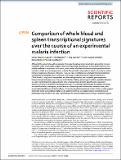Files in this item
Comparison of whole blood and spleen transcriptional signatures over the course of an experimental malaria infection
Item metadata
| dc.contributor.author | Talavera-López, Carlos | |
| dc.contributor.author | Bediako, Yaw | |
| dc.contributor.author | Lin, Jing wen | |
| dc.contributor.author | Valletta, John Joseph | |
| dc.contributor.author | Recker, Mario | |
| dc.contributor.author | Langhorne, Jean | |
| dc.date.accessioned | 2020-06-25T16:30:01Z | |
| dc.date.available | 2020-06-25T16:30:01Z | |
| dc.date.issued | 2019-11-01 | |
| dc.identifier | 268155372 | |
| dc.identifier | f9ca573c-b1fb-4231-83fa-baca9412939b | |
| dc.identifier | 85074297066 | |
| dc.identifier | 31676877 | |
| dc.identifier.citation | Talavera-López , C , Bediako , Y , Lin , J W , Valletta , J J , Recker , M & Langhorne , J 2019 , ' Comparison of whole blood and spleen transcriptional signatures over the course of an experimental malaria infection ' , Scientific Reports , vol. 9 , 15853 . https://doi.org/10.1038/s41598-019-52388-y | en |
| dc.identifier.issn | 2045-2322 | |
| dc.identifier.uri | https://hdl.handle.net/10023/20152 | |
| dc.description | This work receives funding from the Wellcome Trust (WT102907) and the Francis Crick Institute (FC 10101), which receives its funding from the UK Medical Research Council, Cancer Research UK, and the Wellcome Trust, UK. | en |
| dc.description.abstract | Although the spleen is broadly accepted as the major lymphoid organ involved in generating immune responses to the erythrocytic stages of the malaria parasite, Plasmodium, human splenic tissue is not readily available in most cases. As a result, most studies of malaria in humans rely on peripheral blood to assess cellular immune responses to malaria. The suitability of peripheral blood as a proxy for splenic immune responses is however unknown. Here, we have simultaneously analysed the transcriptomes of whole blood and spleen over 12 days of erythrocytic stage Plasmodium chabaudi infection in C57BL/6 mice. Using both unsupervised and directed approaches, we compared gene expression between blood and spleen over the course of infection. Taking advantage of publicly available datasets, we used machine learning approaches to infer cell proportions and cell-specific gene expression signatures from our whole tissue transcriptome data. Our findings demonstrate that spleen and blood are quite dissimilar, sharing only a small amount of transcriptional information between them, with transcriptional differences in both cellular composition and transcriptional activity. These results suggest that while blood transcriptome data may be useful in defining surrogate markers of protection and pathology, they should not be used to predict specific immune responses occurring in lymphoid organs. | |
| dc.format.extent | 2340921 | |
| dc.language.iso | eng | |
| dc.relation.ispartof | Scientific Reports | en |
| dc.subject | QR180 Immunology | en |
| dc.subject | DAS | en |
| dc.subject | SDG 3 - Good Health and Well-being | en |
| dc.subject.lcc | QR180 | en |
| dc.title | Comparison of whole blood and spleen transcriptional signatures over the course of an experimental malaria infection | en |
| dc.type | Journal article | en |
| dc.contributor.institution | University of St Andrews. Statistics | en |
| dc.identifier.doi | 10.1038/s41598-019-52388-y | |
| dc.description.status | Peer reviewed | en |
This item appears in the following Collection(s)
Items in the St Andrews Research Repository are protected by copyright, with all rights reserved, unless otherwise indicated.

